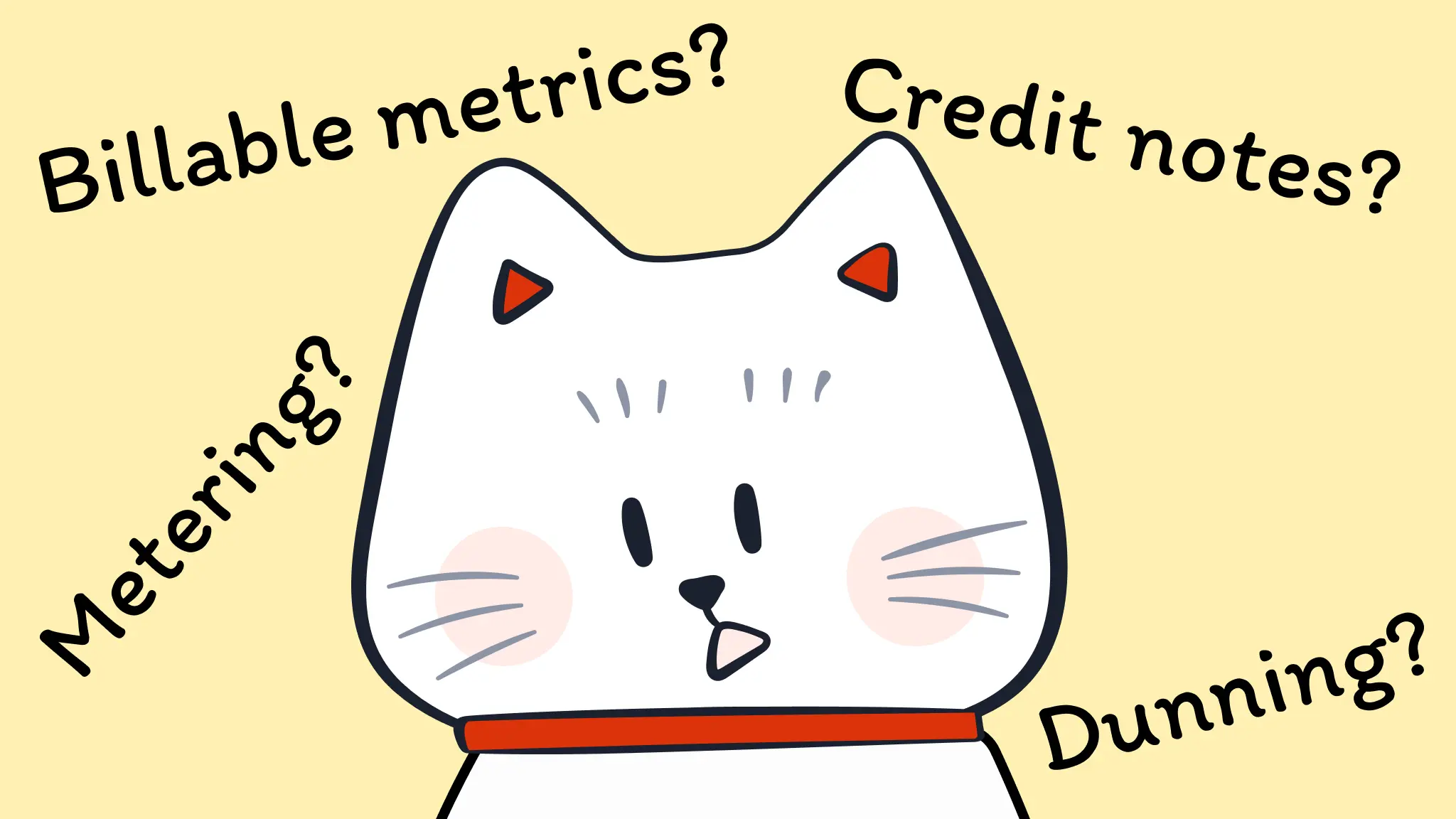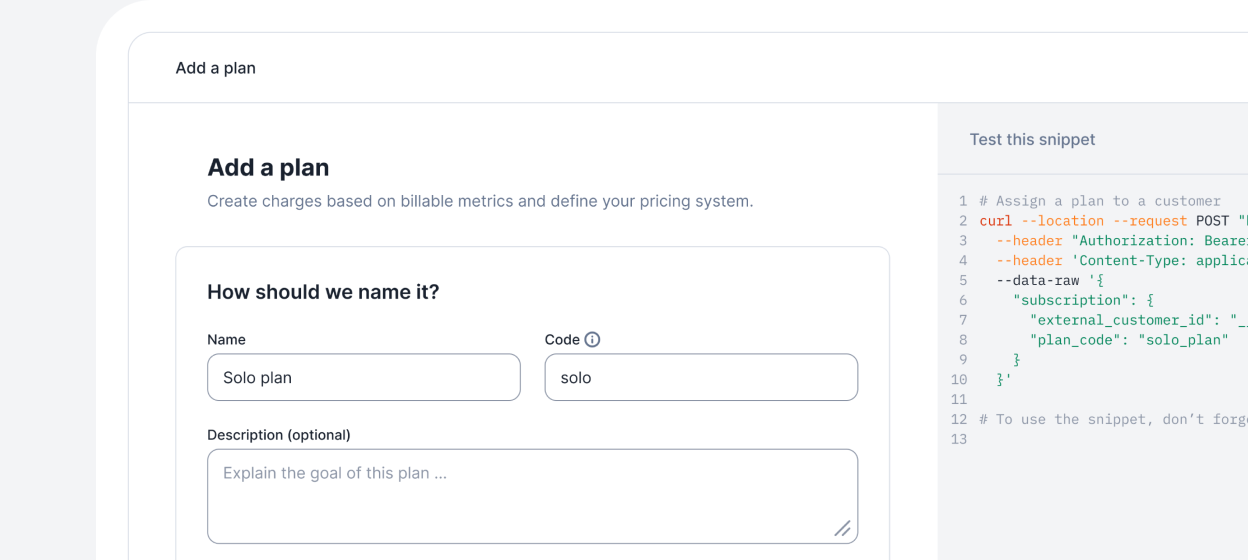Pricing and Billing Guide: All the terms you need to know

Let me guess: You're currently working on building billing and/or pricing systems and the meetings are so full of new vocabulary it's giving you flashbacks to 8th grade Spanish class. You're secretly wishing a company that builds a solution for usage-based billing systems would just explain it all to you in one smooth blog post.
Well, if that's what you wished for (oddly specific but okay), here it is: The most important vocab you need to know to make the finance/RevOps team think you're one of them!
Just bookmark it and cmd+f for a term that confuses you. Or just dive right in and read start to finish. Here you go:
Working on billing? Here are all the terms you need to know
Coupons
Definition: Coupons are promotional codes or vouchers that offer discounts or special offers on products or services. In billing engines, coupons can be applied to invoices or subscriptions to provide customers with discounted rates, free trials, or other incentives.
Use Cases:
- Promotional Discounts: SaaS companies launching new products can create limited-time coupon codes for discounts. By integrating Lago's billing engine, these codes can be seamlessly applied to invoices.
- Customer Retention and Upselling: Fintech companies can create upgrade coupons to encourage existing customers to explore premium plans, enhancing customer loyalty and revenue.
Considerations and Risks:
- Coupon Code Management: Ensure unique and secure codes to prevent misuse. Implement safeguards like expiration dates and usage limits.
- Discount Stacking: Define rules to avoid excessive discounting from multiple coupons.
- Expiration Handling: Configure billing engines to transition seamlessly from discounted to regular pricing post-expiration.
- Impact on Analytics: Ensure accurate tracking and reporting of coupon usage for assessing campaign ROI.
Billable Metric
Definition: A quantifiable unit or measurement used to determine charges or fees associated with a product or service.
Use Cases:
- Data Storage: Cloud storage providers bill based on the amount of data stored.
- API Calls: Communication API providers bill per API call usage.
Considerations and Risks:
- Granularity: Define precise measurement criteria for fairness in billing.
- Variable Pricing Models: Ensure accurate application of complex pricing structures.
- Integration with Tracking Systems: Real-time usage tracking is critical for accuracy.
- Scalability: Handle increased data volumes efficiently as businesses grow.
Credit Notes
Definition: Documents issued by businesses to acknowledge and record amounts owed to a customer, often used for billing corrections, refunds, or future credits.
Use Cases:
- Billing Error Correction: Rectify overcharges or incorrect pricing.
- Product Returns: Provide credits for returned items or refunded amounts.
Considerations and Risks:
- Accurate Generation: Calculate and apply credits correctly.
- Integration with Accounting: Synchronize with financial systems to ensure accuracy.
- Tracking and Reporting: Maintain visibility into credit note activities.
- Fraud Prevention: Implement access controls and validation checks.
Dunning
Definition: The process of communicating with customers about overdue payments to encourage timely settlement.
Use Cases:
- Payment Reminders: Automated notifications for missed payments.
- Collection Notices: Escalate efforts for outstanding payments.
Considerations and Risks:
- Compliance: Adhere to laws governing communication frequency and content.
- Customer Relationship Management: Balance collections with professionalism.
- Automation and Personalization: Tailor communications for higher effectiveness.
- Data Security: Protect sensitive payment information.
Grandfathering
Definition: Allows existing customers to retain benefits or pricing from previous agreements despite changes in terms for new customers.
Use Cases:
- Pricing Grandfathering: Retain old pricing for loyal customers during price increases.
- Feature Grandfathering: Allow existing customers to keep previous feature sets.
Considerations and Risks:
- Communication: Clearly inform customers about grandfathering terms.
- Administration: Efficiently track grandfathered customers.
- Fairness: Balance loyalty rewards with business growth opportunities.
- Future Changes: Plan for revisiting grandfathering policies.
Freemium
Definition: A business model offering free basic versions of a product with premium upgrades available for a fee.
Use Cases:
- Basic Free Version: Attract a large user base with free features.
- Premium Upgrades: Offer advanced functionality or features for a fee.
Considerations and Risks:
- Value Proposition: Ensure the free version provides enough value to attract users.
- Monetization Strategy: Design premium offerings to encourage conversions.
- Scalability: Balance free service costs with revenue from premium users.
- User Conversion: Employ strategies like promotions to convert users to premium plans.
Free Trial
Definition: A limited-time offer allowing users to experience a product’s features for free.
Use Cases:
- Product Evaluation: Allow potential customers to test a product.
- Customer Acquisition: Attract new users and drive conversions.
Considerations and Risks:
- Trial Duration: Set optimal periods to balance evaluation and urgency.
- Onboarding and Support: Provide resources to ensure a positive trial experience.
- Conversion Strategies: Use personalized follow-ups and discounts to convert users.
- Data Privacy: Ensure secure handling of trial user data.
Per Seat Pricing
Definition: A billing model where cost is based on the number of individual users or seats accessing the service.
Use Cases:
- SaaS Models: Charge per user for access to software.
- Collaboration Tools: Bill organizations based on the number of active users.
Considerations and Risks:
- Scalability: Allow for adjustments as team sizes change.
- User Management: Ensure accurate seat tracking and billing.
- Pricing Complexity: Offer clear and tiered pricing options.
- Fairness: Balance flexibility with equitable pricing.
Bulk Pricing
Definition: A pricing strategy where unit costs decrease as purchase volumes increase.
Use Cases:
- Wholesale Transactions: Offer discounts for bulk purchases.
- B2B Sales: Provide tiered pricing for larger quantities.
Considerations and Risks:
- Cost Analysis: Set thresholds aligned with profitability.
- Communication: Clearly outline bulk pricing benefits.
- Pricing Flexibility: Use scalable billing systems for tiered discounts.
Graduated Pricing
Definition: A tiered pricing model where costs vary based on usage thresholds.
Use Cases:
- Quantity-Based Pricing: Adjust costs as order volumes increase.
- Usage-Based Pricing: Scale costs with service usage.
Considerations and Risks:
- Structure Design: Clearly define tiers and transitions.
- Value Communication: Highlight benefits of higher tiers.
- Billing Accuracy: Use automated systems for tier calculations.
Usage-Based Pricing
Definition: Customers are billed based on actual usage of a product or service.
Use Cases:
- Metered Utilities: Charge for exact consumption of services like electricity.
- Cloud Services: Bill for computing or storage resources used.
Considerations and Risks:
- Accurate Measurement: Ensure reliable usage tracking.
- Transparent Pricing: Clearly communicate costs and calculations.
- Customer Education: Provide tools to monitor usage.
Pay-As-You-Go
Definition: Customers pay based on actual usage without fixed commitments.
Use Cases:
- Telecommunications: Charge per minute, message, or data usage.
- Cloud Services: Flexible billing based on real-time resource consumption.
Considerations and Risks:
- Usage Monitoring: Implement accurate tracking tools.
- Cost Control: Provide analytics for customers to manage usage.
- Scalability: Ensure systems can handle varying demands.
Value-Based Pricing
Definition: Pricing aligned with the perceived value delivered to customers.
Use Cases:
- Innovative Solutions: Price based on outcomes, like improved efficiency.
- Custom Offerings: Tailored pricing for specific customer needs.
Considerations and Risks:
- Value Communication: Articulate benefits and ROI clearly.
- Alignment: Balance price with customer-perceived value.
- Measurement: Establish metrics to validate value.
Credit-Based Pricing
Definition: Customers purchase credits redeemable for products or services.
Use Cases:
- Digital Media: Use credits for e-books or video streaming.
- Marketplaces: Unified credit systems for multi-vendor transactions.
Considerations and Risks:
- Conversion Clarity: Define credit-to-currency rates.
- Tracking: Ensure real-time credit management.
- Transparency: Communicate terms and restrictions effectively.
Dynamic Pricing
Definition: Real-time price adjustments based on demand, supply, and market conditions.
Use Cases:
- E-commerce: Adjust prices based on competitor rates or inventory.
- Ride-Sharing: Surge pricing during high-demand periods.
Considerations and Risks:
- Data Analysis: Use real-time analytics for pricing decisions.
- Customer Trust: Explain price fluctuations transparently.
- System Automation: Ensure scalability for dynamic changes.
Hybrid Pricing
Definition: Combines multiple pricing strategies for tailored solutions.
Use Cases:
- Bundled Offers: Internet and TV service packages.
- Tiered Subscriptions: Variable pricing based on feature access.
Considerations and Risks:
- Customer Segmentation: Tailor components to different needs.
- Complexity Management: Simplify pricing structures for clarity.
- Billing Automation: Use robust systems to manage hybrid models.
ARR/MRR/Committed MRR
Definition: Metrics to measure recurring revenue over time.
Use Cases:
- Revenue Forecasting: Project annual or monthly revenue.
- Retention Analysis: Track churn and customer loyalty.
Considerations and Benefits:
- Predictability: Use metrics for financial planning.
- Communication: Share metrics with stakeholders transparently.
NRR
Definition: Net Revenue Retention measures revenue growth from existing customers.
Use Cases:
- Upselling Success: Evaluate revenue expansion efforts.
- Retention Tracking: Monitor customer satisfaction and churn.
Considerations and Benefits:
- Churn Insights: Address revenue loss proactively.
- Growth Projections: Use for strategic planning.
ACV
Definition: Annual Contract Value measures revenue from customer contracts over 12 months.
Use Cases:
- Contract Analysis: Assess average deal sizes.
- Pricing Strategy: Optimize contract values.
Considerations and Benefits:
- Forecasting: Inform resource allocation and budgeting.
- Communication: Report metrics effectively to investors.
True-Up
Definition: Reconciliation of estimated or prepaid usage with actual consumption.
Use Cases:
- Software Licensing: Adjust fees for additional users.
- Cloud Resources: Reconcile increased resource usage.
Considerations and Risks:
- Accurate Tracking: Monitor real-time usage.
- Transparent Adjustments: Communicate true-up policies clearly.
Value Metric
Definition: Pricing tied to a specific measurement of customer usage or benefit.
Use Cases:
- API Usage: Charge per API call.
- Data Storage: Bill based on consumed storage capacity.
Considerations and Risks:
- Alignment: Ensure pricing matches delivered value.
- Transparency: Clearly define metrics and thresholds.
- Automation: Use tools to monitor and bill accurately.
Focus on building, not billing
Whether you choose premium or host the open-source version, you'll never worry about billing again.
Lago Premium
The optimal solution for teams with control and flexibility.

Lago Open Source
The optimal solution for small projects.

